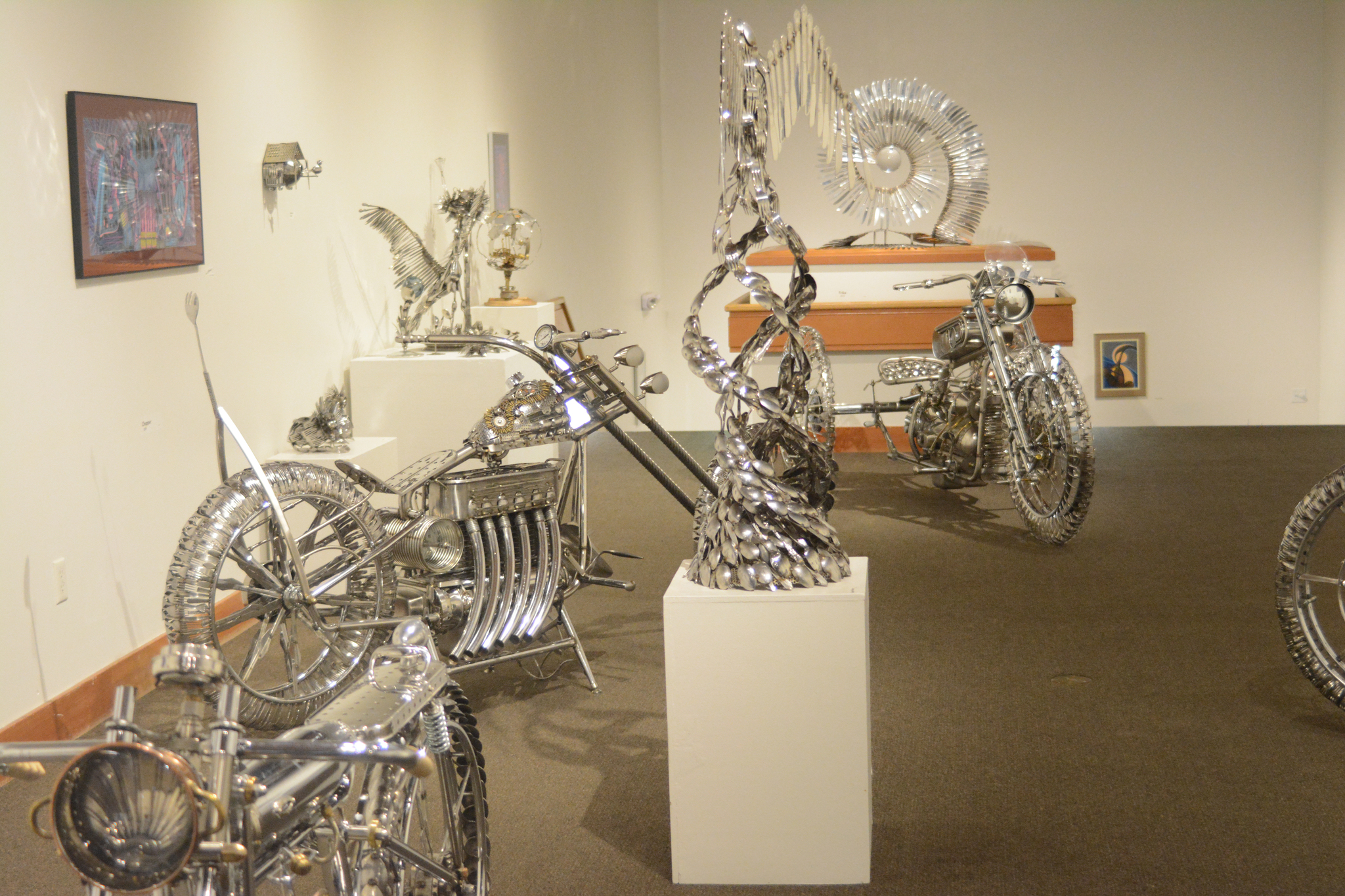In the found-object steel sculptures that have become Homer artist Don Henry’s trademark, forks, knives and spoons turn into sailing ships, birds and flowers. In Henry’s retrospective show at the Pratt Museum, Bikes by the Bay, the longtime and prolific artist has created full-scale sculptures you can sit in and straddle.
While the show features a wide array of Henry’s work, five motorcycle sculptures built from 2003 to last year dominate the show. His first Pratt exhibit, the museum’s upstairs gallery offers Henry something he didn’t have at smaller spaces.
“I’ve got a place I can put all five bikes,” he said. “That’s a great place to show because there’s plenty of room.”
Henry, now 68 and retired since 2011 from his job as chief mechanic at Homer Public Works, might be the most widely shown artist in Homer. While working for the city, his talents didn’t get wasted, and he sometimes served as an unofficial artist in residence. On the city’s dime he built works like the airplane sculpture by the Homer Airport and numerous payment boxes, signs and gates seen at city campgrounds, dump stations and the harbor.
“I was lucky enough to build some stuff for the city during working hours,” Henry said.
His sculptures also can be seen at local galleries and even at the Homer Theatre, where he built a transformer robot out of the historic theater’s old 35mm film projector. Part of the fun with Henry’s work comes from figuring out what he used to create his art.
For example, a list for one bike, the Tracker, includes hand railing, snack tray, fish poacher, lamp parts, cargo tie downs, wheelchair parts, well water pump, fire nozzle, Leatherman tools, gun bolt, kitchen utensil handles, a pasta maker press plate and, of course, forks, spoons and butter knives. Henry said he had one rule inmaking his replica motorcycles: don’t use any actual bike parts.
“It took me a long time to figure out what I could use without using anything that belonged to a motorcycle or bicycle,” Henry said. “That was a tough one.”
For the wheels, Henry used hubs from old metal wheelchairs — a hard commodity to find now that wheelchairs use high-tech, lightweight plastic. The tires look like something from an Apollo moon mission rover, with forks bent in curves and welded together into a rim.
Henry starts each bike with the engine, then builds the wheels and finally the frame. Components like headlights and sissy bars get added. On his chopper, a long-fork cycle right out of Easy Rider, the back of the sissy bar is a serving tong. Each bike takes him about two- to three years to build. Selling for $15,000 each, they’re less expensive than a classic restored motorcycle — and without the grease, gas and oil.
“Buy one of those and you don’t have to deal with fluids and everything else,” Henry said.
Of course, you can’t ride them. Motorcycle aficionados consider some of the old bikes to be works of art. Henry’s art bikes might be just the thing for a lover of motorcycles to put in their living room instead of a working machine.
“Maybe it will save some of those old bikes and keep them on the road,” Henry said.
Henry first came to Homer in 1984 to work at Public Works. That gave him a steady supply of old parts to turn into art. He still fills in part time at Public Works and likes to visit his former workmates.
“I don’t miss the work, but I miss the guys,” he said.
They still set aside broken and worn out machinery for him to repurpose into his art. Some of his bikes were made from parts like fire extinguishers and old water valves.
Bikes By the Bay also features Henry’s pen-and-ink and colored pencil drawings. Henry first draws the design in ink and then goes back and colors them with pencils. Some he did for a show called Millworks, drawings of machines. Other drawings are of a tidepool series.
“They’re kind of wild for tidepools. They’re almost astro pools,” he said. “That’s the fun, making stuff up.”
The Pratt invited Henry to do a show after he was asked to sell his sculptures at the museum store. While many galleries only will exhibit works offered for sale, the Pratt let him show works from private collections — all the “not for sale” pieces in Bikes By the Bay. That gave Henry the opportunity to pull together pieces he’s given to friends. While the bikes represent the high-end of works for sale, many pieces are reasonably priced at less than $500 — a bargain price for an artist of Henry’s longevity and stature.


